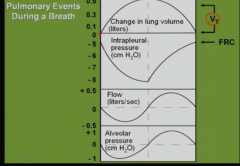![]()
![]()
![]()
Use LEFT and RIGHT arrow keys to navigate between flashcards;
Use UP and DOWN arrow keys to flip the card;
H to show hint;
A reads text to speech;
16 Cards in this Set
- Front
- Back
|
What is the primary function o the respiratory system? |
Maintain systemic arterial blood gas levels within normal range. |
|
|
What does treatment of respiratory disorders require? |
understanding of factors governing ventilation (gas flow), diffusion o gases, and perfusion (blood flow) with the lungs. |
|
|
Properties of lungs |
Lungs specialized for gas diffusion Internal surface area of 50-100 m2 (method high SA: repeated branching of airways, starting at trachea and terminating in over 300 million closed air sac alveoli. Alveoli surrounded by dense network of pulmonary capillaries > 4 layers pulmonary capillary network: > thin layer surface liquid, alveolar lining type 1 pneumocytes + basement membrane, thin layer interstitial fluid, pulmonary capillary endothelial cells + basement membrane. |
|
|
Respiratory gas levels |
Physical laws explain volume, pressure, temperature of gases Boyle's law: p1v1 =p2v2 Charles' law: v1/v2 = t1/t2 Dalton's law: P total = sum (n, x = 1) P gas(x) Henry's law: Cx = K Px (volume gas dissolved in a liquid is directly proportional to its partial pressure) |
|
|
Normal alveolar gas concentrations |
PO2 = 100 mm Hg (calculation: [0.21 x (760 - PH2O (47)] PCO2 = 40 mm Hg PH2O = 47 mm Hg (H2O vapor pressure) PN2 = 573 mm Hg PB = 760 mm Hg |
|
|
Lung volumes + capacities |
Lung volumes: TV (Tidal volume): Volume of a quiet breath Inspiratory reserve volume (IRV): Volume inspired above VT Expiratory reserve volume: Volume air expired after normal expiration Residual volume: remaining air in lungs after ERV released Lung capacities: Inspiratory capacity = VT + IRV Vital capacity: TV + IRV + ERV Total lung capacity: IRV + VT + ERV + RD Functional residual capacity = RV + ERV |
|
|
Airway anatomy |
Conducting zone: 1st 15-16 generations of airway (trachea to bronchioles (terminal) Respiratory zone: 17-23 generations (end terminal bronchioles, respiratory bronchioles, alveoli) |
|
|
Transpulmonary pressure calculation |
(PTP) = Alveolar pressure (PA)- Intrapleural pressure (PIP) |
|
|
Static compliance calculation |
Cstat = VT/ delta PTP C stat = static compliance VT = tital volume PTP = transpulmonary pressure |
|
|
What is the factor for sub atmospheric pressure? |
Opposing recoil of the lungs and chest recoil. Mechanism: When all respiratory muscles relaxed, lungs at resting lung volume (RRC = ERV + RV) there is equilibrium between recoil of lung and chest wall Thus at this point, lungs tend to collapse and the chest wall tends to expand, with the 2 being held together by a thin layer of pleural fluid. By acting to pull the lung and chest wall apart, the opposing recoil forces create negative pressure in the intracellular space. |
|
|
Relationship between PO2, PCO2 on respiration |
Increase PCO2, increase rate respiration Increase PO2, increase depth respiration |
|
|
When is there the greatest air flow into alveolus? |
Mid inspiration (b/c greatest pressure gradient greatest, when PAlv = -1) |
|
|
Difference between restrictive and obstructive disease? |
Restrictive disease (i.e: pulmonary fibrosis) : Inability to develop -1 mm hg alveolar presusre during mid inspiration (inability for air flow via positive > negative pressure) (becomes 0 at end inspiration) Obstructive disease: Inability for air to flow from atmosphere > conductive zone > respiratory zone (inability for alveolar pressure +1 during expiration) (remained expanded alveoli, i.e: emphysema (classical due to lost elasticity in alveolar walls), asthma, chronic bronchitis |
|
|
What are the pulmonary events during respiration? |

|
|
|
Law of laplace |
T = 2P/R |
|
|
What 2 factors promoting alveolar collapse. Factors preventing this. |
Surface tension Law of laplace (T = 2P/R) Surfactant production by type 2 pneumocytes 2 weeks before birth (lack surfactant: RDS (Respiratory distress syndrome) > Properties surfactant: >Decreases surface tension by interfering with air/water interfere (decreasing collapsibility of the lungs) Increase lung compliance >opposing laplace effect of small alveoli) >opposing capillary filtration > Deficiency surfactant: |

